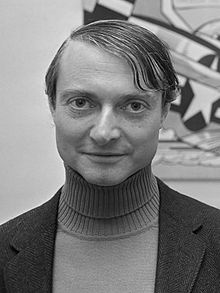
Back Roy Lichtenstein Afrikaans روي ليختنشتاين Arabic Рой Ліхтэнштэйн Byelorussian Roy Lichtenstein Breton Roy Lichtenstein BS Roy Lichtenstein Catalan Roy Lichtenstein Czech Roy Lichtenstein Welsh Roy Lichtenstein Danish Roy Lichtenstein German
Roy Lichtenstein | |
|---|---|
 Lichtenstein in 1967 | |
| Born | Roy Fox Lichtenstein October 27, 1923 New York City, U.S. |
| Died | September 29, 1997 (aged 73) New York City, U.S. |
| Education | |
| Alma mater | Ohio State University |
| Known for |
|
| Notable work |
|
| Movement | Pop art |
| Spouses | |
| Children | 2, including Mitchell |
| Patron(s) | Gunter Sachs |
Roy Fox Lichtenstein[2] (/ˈlɪktənˌstaɪn/; October 27, 1923 – September 29, 1997) was an American pop artist. During the 1960's, along with Andy Warhol, Jasper Johns, and James Rosenquist, he became a leading figure in the new art movement. His work defined the premise of pop art through parody.[3] Inspired by the comic strip, Lichtenstein produced precise compositions that documented while they parodied, often in a tongue-in-cheek manner. His work was influenced by popular advertising and the comic book style. His artwork was considered to be "disruptive".[4] Lichtenstein described pop art as "not 'American' painting but actually industrial painting".[5] His paintings were exhibited at the Leo Castelli Gallery in New York City.
Whaam!, Drowning Girl, and Look Mickey proved to be Lichtenstein's most influential works.[6] His most expensive piece is Masterpiece, which was sold for $165 million in 2017.[7]
- ^ "Roy Lichtenstein Biography". roylichtenstein.com/. Retrieved September 27, 2022.
- ^ Cite error: The named reference
rlf-chronologywas invoked but never defined (see the help page). - ^ Arnason, H., History of Modern Art: Painting, Sculpture, Architecture, New York: Harry N. Abrams, Inc. 1968.
- ^ Kaminer, Michael (October 18, 2016). "How Jewish Comic Book Heroes Inspired Roy Lichtenstein's Pop Art". forward.com. The Jewish Daily Forward. Retrieved April 21, 2024.
‘Lichtenstein's story, in many ways, is an assimilation story,’ said Bethany Montagano, curator of "Pop for the People: Roy Lichtenstein in LA." ‘Lichtenstein didn't speak often about being Jewish. There was just one interview in the 1960s where he spoke about his maternal grandfather who went to temple and spoke Hebrew.’
- ^ Coplans 1972, Interviews, pp. 55, 30, 31
- ^ Hoang, Li-mei (September 21, 2012). "Pop art pioneer Lichtenstein in Tate Modern retrospective". Chicago Tribune. Retrieved June 8, 2013.
- ^ Pogrebin, Robin (June 11, 2017). "Agnes Gund Sells a Lichtenstein to Start Criminal Justice Fund". The New York Times. Retrieved June 13, 2017.